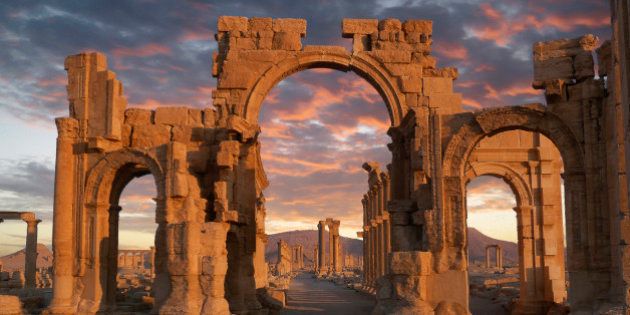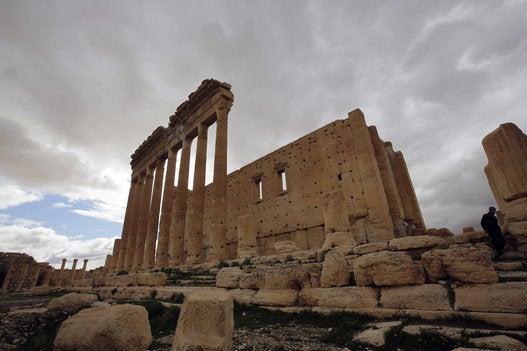
The magnificent Arch of Triumph at Palmyra destroyed -- when I heard, it was like losing a good friend. Palmyra, or Tadmur as it was called locally, would spring into view suddenly as one drove from Damascus. In the desert around, the first to hit the eye were swaying green fronds of date trees, and then the pink ruins would appear. Scattered in the desert like jewels. Palmyra, an old stopover on the trade routes, was the pride of Queen Zenobia -- a mélange of history, culture, religion and civilisation. Standing majestically in the heart of the Syrian desert, it represented hope and human endeavour.
Having lived in Syria for about three years, from 2003 to 2006, every simmering city I read about in that country today has a memory. Each city and place that hits the headlines for the wrong reasons recalls people and echoes attached to it.
"Aleppo is in ruins now and I often wonder how all the people I had met are doing."
Palmyra is an oasis in the Homs governorate. Homs, a hotbed of trouble, was a city we crossed innumerable times. The oil refinery at the outskirts of the city was its landmark. Unlike most other Syrian cities, Homs did not have any great architectural or historical attraction. Its people filled this gap. "Homsi" jokes and humour were legend across Syria, and no gathering would be complete until someone cracked a Homsi joke. I often reflect these days if, when all this is over, Homs and Homsi people would still evoke laughter and joy.
Further down the road from Homs was the city of Aleppo or Halab. With a European feel, its souks, ancient citadel, Grand Mosque and Armenian churches were a delight to discover. Aleppo and Damascus both claimed to be the most ancient living cities in the world, and residents competed about them much like Dilliwallahs and Mumbaikars! Aleppo is in ruins now and I often wonder how all the people I had met are doing.
I have travelled to Aleppo on two occasions in the public transport bus from Damascus. A lone and foreign-looking woman, with a bindi adorning her forehead. However, I have never been stared at or troubled. Most locals would smile and politely enquire, "Hindi?" India or "Hind" evoked a warm response in every nook and corner of the country, a legacy from the days of the ancient trade routes. The Syrian landscape that passed my eyes through the window of the bus is now transformed into rubble, now that Aleppo has become a battleground.
In summer or winter, for a breath of fresh air we would drive to Al-Zabadani. Near Damascus, it was a beautiful resort town. Green, hilly, serene and beautiful, it had many restaurants and small hotels - it was a great chill-out place. One day, when it had snowed heavily, we drove to Zabadani. We stopped near a snow-covered slope, and in a corner, began playing in the snow. Soon a snowball came and hit my daughter. We realised that a large group of Syrians cavorting there had included us foreigners in their game. For a while, we ran, rolled and glided on the snow with them. Shared their food, tried to converse in our minimal Arabic, and then exhausted, wet and shivering made our way back to Damascus. Until they disappeared from our view, we waved to each other. It is impossible even to imagine a place like Zabadani under siege.
"[W]hen I think about these places in Syria, it seems like another age, another time. It is as if a friend left behind suddenly reappears in an unrecognisable avatar."
Daraa, where all the trouble began in 2011, was always a stopover when we were driving to Amman, Jordan. We visited whenever we had guests because the fabulous Roman amphitheatre at Bosra was there. We would run into Syrian families picnicking on the steps of the magnificent theatre, and they would invariably invite us to partake of their meals. We once attended a musical concert at that ancient site, with the sound reverberating -- with no mikes -- in a crowd of more than 10000!
The pulse of Syria was Damascus. From modern structures to its Old Mosque, the spotless bylanes of the old city to its modern Tishreen Park, it grew on you like a silent lover. It had huge restaurants that were like food factories where people congregated and spent long hours. It hosted marches, protests and rebellions. With Mount Qasioun as its backdrop, and the Barada River flowing nearby, Damascus throbbed with the flow of countless civilisations that have passed through its portals. It dressed up for Ramadan and for Christmas, and its people were warm and friendly.
These days when I think about these places in Syria, it seems like another age, another time. It is as if a friend left behind suddenly reappears in an unrecognisable avatar. However, places are only dots on the map without their people, and there is something special about the Syrian people.
Having lived for centuries at the crossroads of history, with empires, monarchs, rebels, ideas and ideologies blowing across their land the Syrians embody a civilisational strength that is unmatched. It meets and greets you in unexpected places. In the middle of Ramadan, a group of Indians could sprawl on the shores of the sparkling Mediterranean at Tartous and enjoy lunch, with locals waving enthusiastically as they passed by. When the protests against a Danish newspaper's Mohammed cartoons spilled over onto the streets on Damascus in 2006, the Danish embassy was set on fire. That evening when things were quiet, we walked down to the street towards the Danish embassy. Next to the embassy was a church. The church building stood there untouched with not even a scratch.
From the first written word in Ugarit, the majestic ruins of Palmyra, Roman remains and crusader castles, to the bustling souks of Damascus, its churches and numerous grand mosques, Syrians have the tradition of humanity embedded in them. It is this eternal and inclusive spirit of the Syrian people that I hope endures the current upheaval in their nation.



Contact HuffPost India
